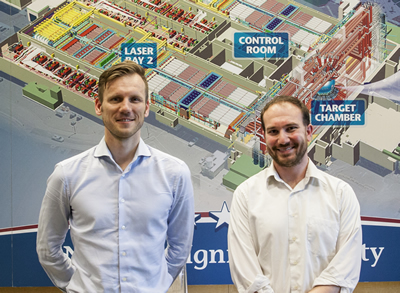Experimental Highlights - 2017
July
The Symmetry Challenge: Peering Inside the Hohlraum
NIF-Rochester Team Limits Direct-Drive Energy Losses
In the precision world of lasers, the direct-drive approach to inertial confinement fusion (ICF) could be considered the equivalent of riding a horse without a saddle. Like bareback riders able to control their mounts through direct physical contact, researchers using direct drive couple laser energy onto a fusion capsule without employing a hohlraum, as in the indirect-drive technique typically used on NIF. In both approaches, the laser energy causes the surface of the capsule to ablate, or blow off, resulting in a rocket-like implosion that heats and compresses the hydrogen fuel inside until the hydrogen atoms fuse and release energy.
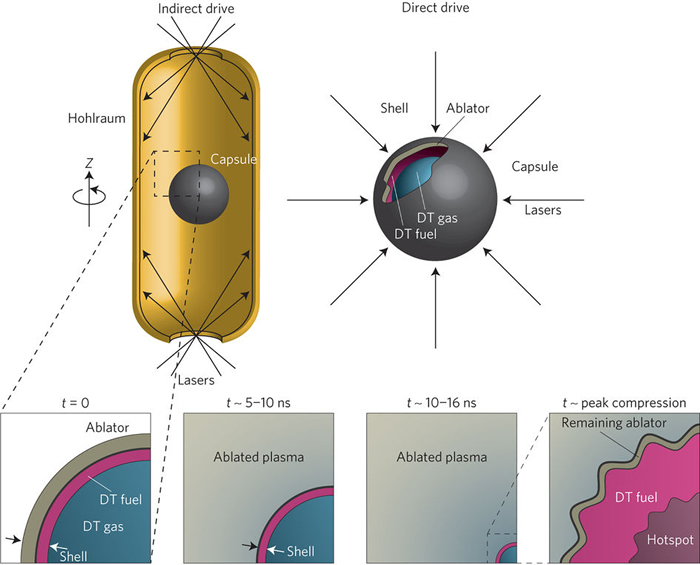 Typical targets used in laser-driven ICF are indirectly driven (upper left) and directly driven (upper right). In both cases, a spherical capsule is prepared with a layer of deuterium-tritium (DT) fuel on its inside surface. As the capsule surface absorbs energy and ablates, pressure accelerates the remaining ablator shell and DT fuel inwards—an implosion. By the time the shell is at approximately one-fifth of its initial radius it is travelling at a speed of many hundreds of kilometers per second. By the time the implosion reaches minimum radius, a hot spot of DT has formed, surrounded by colder and denser DT fuel. (From Nature Physics, May 2016)
Typical targets used in laser-driven ICF are indirectly driven (upper left) and directly driven (upper right). In both cases, a spherical capsule is prepared with a layer of deuterium-tritium (DT) fuel on its inside surface. As the capsule surface absorbs energy and ablates, pressure accelerates the remaining ablator shell and DT fuel inwards—an implosion. By the time the shell is at approximately one-fifth of its initial radius it is travelling at a speed of many hundreds of kilometers per second. By the time the implosion reaches minimum radius, a hot spot of DT has formed, surrounded by colder and denser DT fuel. (From Nature Physics, May 2016) Each approach has its advantages and disadvantages: indirect drive, which heats the target capsule in a kind of x-ray “oven,” has the potential to provide a more uniform drive, while direct drive avoids the inefficiencies involved in converting the laser energy into x rays. The ultimate goal of ICF is to deliver enough power to the fusion capsule to reach ignition conditions, when the energy from a self-sustaining fusion reaction outstrips the rate at which x-ray radiation losses and electron conduction cool the implosion. Current direct-drive experiments on NIF, at scales smaller than needed for ignition, aim to understand and improve aspects of direct-drive physics.
In both indirect and direct drive, energy can be lost or misdirected when the laser beams cross on their way to the target, with some beams giving up part of their energy to other beams—a phenomenon known as cross-beam energy transfer, or CBET.
Now a team from NIF and the University of Rochester’s Laboratory for Laser Energetics (LLE) has developed an important mitigation strategy for taming detrimental CBET in direct-drive experiments on NIF. The team’s experiments have demonstrated for the first time a significant change of the CBET behavior in a direct-drive implosion. Their work shows a reduction of the associated energy losses, thereby offering a potential path to increasing the energy coupled to the target with the direct-drive approach.
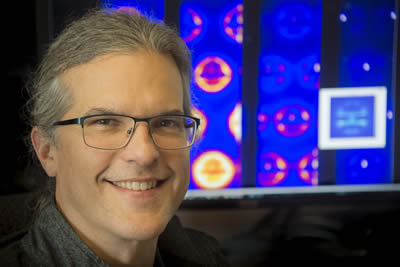 John Marozas of the Laboratory for Laser Energetics developed the concept for wavelength detuning experiments on NIF to assess CBET mitigation in direct drive.
John Marozas of the Laboratory for Laser Energetics developed the concept for wavelength detuning experiments on NIF to assess CBET mitigation in direct drive. CBET can result in losses of as much as 30 percent of the laser energy through uncontrolled light scatter away from the target, thereby limiting the amount of laser energy available to drive the implosion, according to Mike Rosenberg of LLE’s MegaJoule Direct Drive campaign. The CBET energy loss is caused by the laser interacting with the ionized plasma from the implosion target, Rosenberg explained.
“Ultimately, how much energy you can put in determines how well the capsule performs, and whether you can reach ignition conditions in the first place,” he said. “All of it matters—you want every bit of energy you can get, and right now we’re throwing a lot of it away.”
CBET is caused by an intricate interplay among multiple incoming laser beams and the localized plasma conditions, such as density and temperature, that the laser is propagating through, explained NIF experimentalist Matthias Hohenberger. By changing the wavelength of the laser light—its color—in one or more of the interacting beams, researchers can control the magnitude of the CBET process and how much energy it causes to be lost. “And this is exactly what we were able to show in our experiments,” Hohenberger said.
The experiments demonstrated that when overlapping beams of multiple wavelengths irradiate the capsule, the laser energy the capsule absorbs is increased compared to the same experiment with all beams at the same wavelength. To measure this, the researchers looked at how much the shell converged after a certain time, said Rosenberg. “Simply put, the faster it goes, the more laser energy we were able to couple into the capsule.”
While the effects of CBET and its dependence on the wavelength of interacting beams is not a new discovery, its significance for direct-drive ICF has become apparent only in recent years through experimental work on Rochester’s OMEGA Laser.
The multiple-wavelength approach to mitigating CBET in direct drive can hold great potential for gaining momentum in the drive toward ignition, according to Rosenberg and Hohenberger.
“It’s important because it’s the first time it was demonstrated that this is a feasible way of changing the energy coupling in direct drive,” Hohenberger said.
The team also faced challenges in that their experiments exceeded the range of standard work on the laser facility; the wavelength separation required to improve CBET mitigation posed a risk of clipping and damaging the optics. “This was a big development effort for NIF,” Rosenberg said.
While the recent experiments showed the desired effect, the increase in energy absorption was only a few percent, compared to the overall tens of percent losses due to CBET. A new set of experiments to further study CBET mitigation already has been scheduled. “But,” noted Hohenberger, “it’s only the beginning.”
The team has submitted a paper, “First observation of reduced cross-beam energy transfer for direct-drive inertial confinement fusion implosions using wavelength detuning on the National Ignition Facility,” for publication in a peer-reviewed journal. First author John Marozas of LLE was joined by LLNL co-authors Hohenberger, Mark Bowers, Jean-Michel Di Nicola, Gaylen Erbert, Brian MacGowan, Lawrence Pelz, and Steven Yang and LLE co-authors Rosenberg, Timothy Collins, Radha P. Buhukutumbi, Patrick McKenty, Jonathan Zuegel, Frederic Marshall, Sean Regan, Craig Sangster, Wolf Seka, Michael Campbell, and Valeri Goncharov.
The Symmetry Challenge: Peering Inside the Hohlraum
Fourth in a series of articles exploring the progress and challenges of LLNL’s Inertial Confinement Fusion Program.
Article 2—“Taming Symmetry With the 2Shock”
Article 3—“Improving Efficiency with Low-Fill Hohlraums”
Among the many challenges in inertial confinement fusion (ICF) is keeping a target capsule that is large enough to ignite almost perfectly symmetric as it implodes. NIF’s extreme conditions make this difficult—the capsule implodes by a factor of 30 in radius at nearly 400 kilometers per second, magnifying any imperfections that can quench ignition.
One of the keys to controlling symmetry is understanding the conditions in the hohlraum, the small eraser-sized cylindrical container that holds the capsule and drives the implosion. Laser beams enter the hohlraum at the top and bottom and strike its walls, rapidly turning the hohlraum into an x-ray oven.
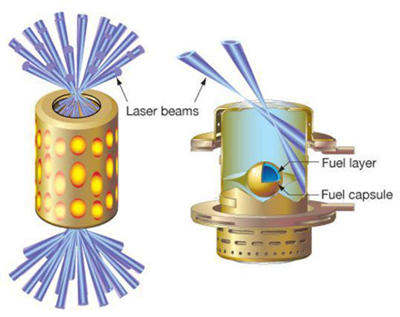 A NIF hohlraum.
A NIF hohlraum. The placement and relative energies of the beams on the hohlraum wall must be carefully balanced to drive the implosion symmetrically. Because the laser pulse is “long” (up to 25 nanoseconds), however, the earlier part of the pulse interacts with the hohlraum to generate a plasma that intercepts the latter portion of the pulse, impeding the laser beampath. Eventually, the laser beams cannot overcome this plasma and symmetry control is lost. This “energy acceptance time” dictates the largest and therefore most robust capsule that can be driven symmetrically, which is important to maximize for ignition.
The dynamic motion of the hohlraum wall is complicated to both model and diagnose, but several new techniques developed by the ICF program aim to peer inside the hohlraum to see exactly what is happening and gather data to inform future experimental design.
In hohlraum spectroscopy, scientists are using different tracer materials in various hohlraum locations to view the expansion and interaction of hohlraum wall plasma with plasma generated by the capsule ablator. As these regions collide, they obscure the propagation of the inner beams, which have to propagate through more plasma, as they are meant to hit the central waist of the hohlraum. The tracer materials allow the researchers to see exactly how the walls are moving during this process and the point at which the collision occurs.
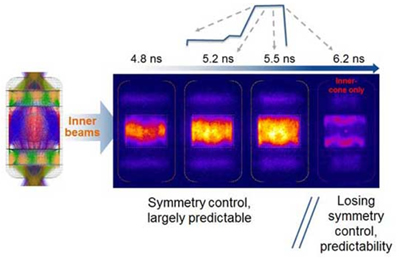
In another approach called thin-wall imaging, the standard 30-micron-thick hohlraums are thinned to as little as eight microns. These thin walls allow the scientists to see through the hohlraum itself and observe exactly when and how the beams strike the walls.
“The thickness of thin wall hohlraums are very carefully designed so they won’t affect the dynamics of what is happening inside,” said Nobuhiko Izumi, an experimental physicist in the ICF program. “This is very important because if it’s too thin, energy could leak out and the hohlraum could cool down, and if it’s too thick, you cannot see inside.”
It has long been known that the hohlraum environment is evolving rapidly during a shot, and for the first time, these x-ray snapshots provide critical data on how the laser energy deposition changes as a function of time, and in particular how and where the plasma “bubble” intercepts the beams aimed at the equator of the hohlraum.
“We’re beginning the process of understanding when we’re having issues, and we’re hoping that with this diagnostic, we can understand also exactly why,” said Joe Ralph, an experimental physicist in the ICF Program. “We already have indications that the plasma bubble growth starts very early in time, even when the laser pulse is not yet so energetic. So we can use this approach to diagnose the problem of hohlraum filling in different platforms and figure out what kind of geometry and target design allows the best beam propagation.”
In the dot spectroscopy approach, plasma temperature is diagnosed in various locations by putting a probe in a “viewfactor” target—a hohlraum with one end cut open so that researchers have a better view of the plasma conditions in the region of the laser entrance hole and the gold bubble.
The spectroscopic probe “dot”—a small disk of manganese and cobalt—becomes ionized, and its x-ray spectra are captured to measure the temperature in different parts of the hohlraum.
“This approach tells you about the laser deposition regions and the heat conductivity from those regions to the rest of the hohlraum,” noted Marilyn Schneider, the radiative properties group leader. “It’s another constraint in what we are measuring and should enable us to improve our simulation models to help future designs.”
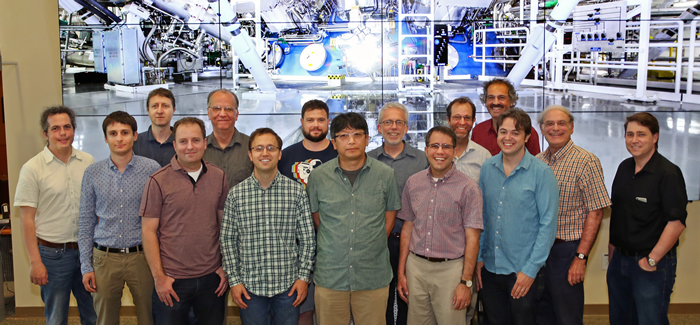 Members of the Hohlraum Science Team (from left): Joe Ralph, Clement Goyon, Mark Sherlock, Steven Ross, Duane Liedahl, Will Farmer, Daniel Thorn, Nobuhiko Izumi, John Moody, Nathan Meezan, Oggie Jones, Klaus Widmann, George Swadling, Mordecai Rosen and Brad Pollock. Credit: Kate Hunts
Members of the Hohlraum Science Team (from left): Joe Ralph, Clement Goyon, Mark Sherlock, Steven Ross, Duane Liedahl, Will Farmer, Daniel Thorn, Nobuhiko Izumi, John Moody, Nathan Meezan, Oggie Jones, Klaus Widmann, George Swadling, Mordecai Rosen and Brad Pollock. Credit: Kate Hunts Each of these approaches is examining an important aspect of hohlraum science, which determines hohlraum behavior; but by breaking a very complex problem into pieces and exploring different aspects using different techniques, ICF scientists can collect more and more data during every experiment. This could lead to a better understanding of the important physics processes in the hohlraum.
This will have huge implications for improving the efficiency of laser energy coupled to the capsule and provide the foundations for well-informed decisions about adaptations to future designs.
“It’s important for us to maximize our data collection,” Ralph said. “The more relevant diagnostics that we have, and the more we can learn from each experiment, the faster we can make progress. Through the combination of these techniques, we’ve made enormous headway in just the past year.”
NIF experiments support the National Nuclear Security Administration’s Stockpile Stewardship Program to ensure the safety, security and reliability of the nation’s nuclear deterrent, while also providing scientists from around the world with unique conditions of heat and pressure for fundamental science studies.
